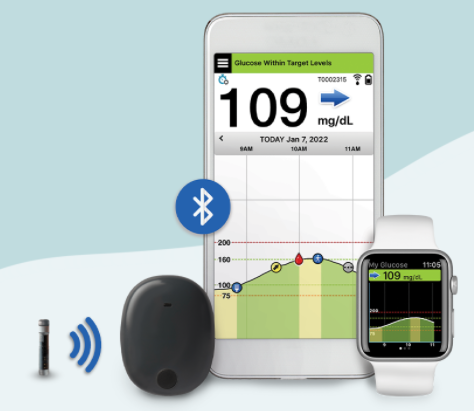Sugar-Free Dark Chocolate Consumption Results in Lower Blood Glucose in Adults With Diabetes was published by Nutrition and Metabolic Insights, 7 February 2022.
 The objective of this study was to determine how sugar-free dark chocolate sweetened with stevia, erythritol, and inulin impacts postprandial blood glucose levels in individuals with diabetes compared to conventional dark chocolate. Results suggest that a sugar-free dark chocolate bar sweetened with stevia, erythritol, and inulin led to a lower blood glucose iAUC compared to the conventional dark chocolate bar in people with diabetes, whilst longer-term effects on glucose control remain to be determined.
The objective of this study was to determine how sugar-free dark chocolate sweetened with stevia, erythritol, and inulin impacts postprandial blood glucose levels in individuals with diabetes compared to conventional dark chocolate. Results suggest that a sugar-free dark chocolate bar sweetened with stevia, erythritol, and inulin led to a lower blood glucose iAUC compared to the conventional dark chocolate bar in people with diabetes, whilst longer-term effects on glucose control remain to be determined.
Chocolate is classified as a high-calorie food due to its high fat and sugar content. The sugar-free dark chocolate in this trial offered fewer calories compared to conventional dark chocolate due to the absence of sugar. Sugar substitutes have gained importance due to the increasing demand for diet products resulting from the growing effort to reduce the ingestion of added sugars.
A sugar-free (stevia, erythritol, and inulin-sweetened) dark chocolate bar led to a lower blood glucose iAUC compared to a conventional dark chocolate bar in people with diabetes. It appears that sugar-free dark chocolate could be consumed without compromising blood glucose control in people with diabetes. Longer-term trials with greater sample sizes will be needed to assess if consumption of sugar-free dark chocolate could have cardiovascular health benefits while improving or not worsening glucose control in diabetes.
Read more: Sugar-Free Dark Chocolate Consumption Results in Lower Blood Glucose in Adults With Diabetes
Long-Term Accuracy and Safety of Next-Generation Implantable Continuous Glucose Monitoring System was reported by Jessica Nye for EndocrinologyAdvisor.com, 23 March 2022.
 The next-generation Eversense continuous glucose monitoring (CGM) system was found to have sustained accuracy and safety up to 180 days, according to the results of a study published in Diabetes Technology & Therapeutics.
The next-generation Eversense continuous glucose monitoring (CGM) system was found to have sustained accuracy and safety up to 180 days, according to the results of a study published in Diabetes Technology & Therapeutics.
Compared with readings from the Yellow Springs Instrument (YSI) bedside glucose analyzer, accuracy of the Eversense CGM on the basis of glucose ranges was 85.6% overall. Accuracy was lowest (82.7%) in the 81 to 180 mg/dL range and highest (90.6%) in the 301 to 350 mg/dL range. The confirmed detection rate for a hypoglycemic or hyperglycemic event was 90% for 60 mg/dL, 94% for 70 mg/dL, 99% for 180 mg/dL, and 98% for 240 mg/dL. Sensor survival was 96% through day 120, 94% at day 150, and 90% at day 180.
20.4% of patients reported an adverse event, most of which were dermatologic (11.6%) followed by hematologic (7.7%) or neurologic (3.9%). Among all sensors, 1.1% were associated with an infection at the incision location. This study was limited by its lack of diversity among study participants.
This study found that the next-generation long-term implantable Eversense CGM system had sustained accuracy and was safe up to 180 days.
Read more: Long-Term Accuracy and Safety of Next-Generation Implantable Continuous Glucose Monitoring System
Hybrid closed-loop glucose control compared with sensor-augmented pump therapy in older adults with type 1 diabetes: an open-label multicentre, multinational, randomized, crossover study was published in TheLancet.com, March 2022.
Older adults with type 1 diabetes have distinct characteristics that can make optimizing glycaemic control challenging. We sought to test our hypothesis that hybrid closed-loop glucose control is safe and more effective than sensor-augmented pump (SAP) therapy in older adults with type 1 diabetes.
INTERPRETATION: Hybrid closed-loop insulin delivery is safe and achieves superior glycaemic control to SAP therapy in older adults with long duration of type 1 diabetes. Importantly this was achieved without increasing the risk of hypoglycemia in this population with risk factors for severe hypoglycemia. This suggests that hybrid closed-loop therapy is a clinically important treatment option for older adults with type 1 diabetes.
By the way, you may have noticed that I didn’t include a graphic. WHY? Because I couldn’t find a SINGLE image of an older adult using a hybrid closed-loop system! Ageist? You bet!
Read more: Hybrid closed-loop glucose control in older adults with type 1 diabetes




Anyone else find that they can’t tolerate the artificial sweeteners in Sugar-Free Chocolate. I have been eating high percentage regular dark chocolate for years. I have more trouble with the caffeine than the sugar, but overall, am better off without too much of it, sadly!
I’m trying to now avoid all sweeteners … quite the challenge for me!
The Eversense has great promise, provided of course, that it ever gets connected to a delivery device.
I like that funky chocolate stuff, not as well as I like regular chocolate but well enough I suppose to try it again.
Finally, next time you need a handsome guy wearing a hybrid closed loop device,,, call someone else. LOL. I do love my pump but Sheryl says I embarrass her if I say I am handsome.